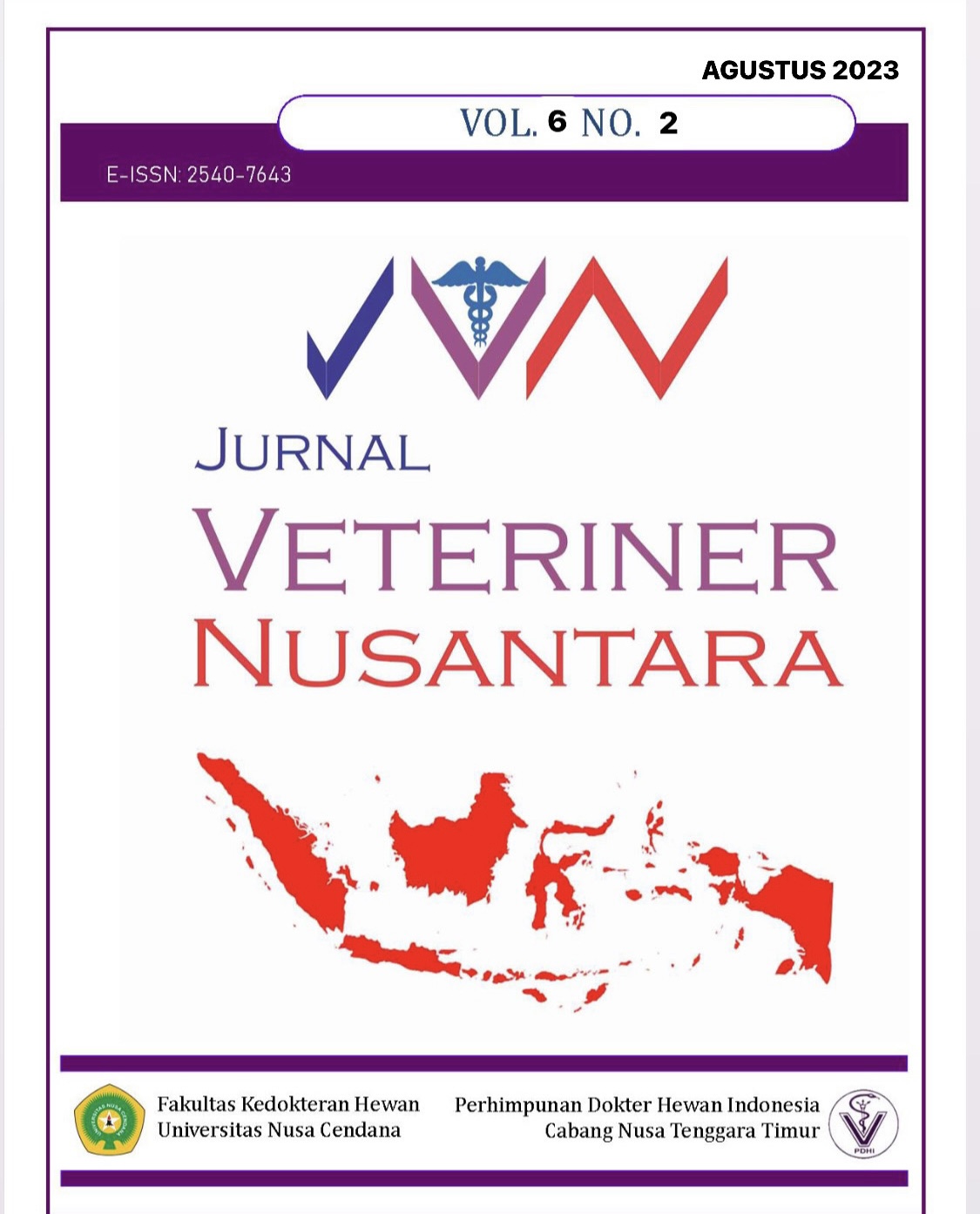Keragaman Jenis Lalat Penghisap Darah Pada Kuda Sumba (Equus caballus) Di Kabupaten Sumba Timur
Abstract
Flies are a type of ectoparasites that can interfere with the
comfortable life of livestock and act as disease vectors. There
are two types of flies, namely sucking flies and non-bloodsucking flies. Types of bloodsucking flies are Tabanus,
Haematopota, Chrysops, Stomoxys, and Haematobia, while
non-bloodsucking flies are Musca and Hydrotae. The purpose
of this study was to determine the species diversity and
abundance of blood-sucking flies on the Sumba Horse (Equus
caballus) located at Paulangga Farms and Paurat Farms,
Kombapari Village, Katala Hamu Lingu District, East Sumba
Regency. Samples of flies were collected using an insect
tweezers. The flies that were caught were put into an insect
killer bottle, then identified under a microscope according to the
species with the identification key Hadi and Soviana (2010).
Furthermore, the data were analyzed descriptively using the
relative abundance formula. The identification results showed
that there were 2 (two) types of blood-sucking flies namely
Tabanus sp. on Paulangga farm (38.19%) and Paurat farm (0%)
and Hippobosca sp. on Paulangga farm (61.81%) and Paurat
Farm (100%). Factors that influence to support the diversity of sucking flies are temperature, humidity, food, and breeding
sites.
Downloads
References
Journal of Biomedical Research. 8(2):113-118.
Gaina, C. D., & Foeh, N. D. F. K. (2019). Studi Performa Umum Tubuh Dan Status Fisiologis Kuda Sumba. Jurnal Kajian Veteriner, 6(2):38–44.
Ganna R. 2007. Program Pengembangan ternak kerbaudi Kabupaten Sumba Timur, Nusa Tenggara Timur. Seminar dan Lokarya Nasional Usaha Ternak Kerbau. 2007 Jun 22-23; Jambi, Indonesia.
Hadi UK, Soviana S. 2010. Ektoparasit. Pengenalan, Identifikasi dan Pengendaliannya. Cetakan Pertama. Bogor: IPB Press.
Hadi, U.K., D.J. Gunandini, S. Soviana, dan S.H. Sigit. 2011. Panduan Identifikasi Ektoparasit: Bidang Medis dan Veteriner. IPB Pr., Bogor.
Khoobdel, M, K. Akbarzadeh, H. Jafari, M.A. Tavana, M.D. Izadi, M. Jazayeri, M.M. Bahmani, M. Salari, M. Akhoond, M.Rahimi, A. Esfahami, M. Nobakht, and J.
Rafienejad. 2013. Diversity and abundance of medically-important flies in the Iranian Triple Island; the Greater Tund, Lasser Tund, and Abu-Musa. Iranian Journal of military Medicine.4(14):327-336.
Levine, N.D. 1990. Buku Pelajaran Parasitologi Veteriner. Gajah Mada University Press., Yogyakarta Putra J. 2012. Identifikasi lalat sumba (Hippobosca Spp.) pada sapi perah di kawasan usaha peternakan sapi perah Cibungbulang Kabupaten Bogor. Skripsi. Fakultas Kedoktran Hewan. Institut Pertanian Bogor. Bogor
Pertanian, K. (2015). Pusat Karantina Tumbuhan dan Keamanan Hayati Nabati Badan Karantina Tumbuhan. Standar perlakuan fumigasi metil bromide dan fosfin pada palka kapal.
Putra, A.K., S. Soviana, dan U.K. Hadi. 2016. Ragam Jenis dan Aktifitas Lalat di Kawasan Usaha Peternakan Sapi Perah Cibungbulang Kabupaten Bogor. Thesis.
Sekolah Pasca Sarjana Institut Pertanian Bogor, Bogor.
Ronohardjo, R., Wilson, A.J (1986). Some aspects of epidemiology dan economics of important diseases of large ruminants in Indonesia. In: Proceeding of the fourth International Symposium on Veterinary Epidemiology dan economics, Singapore.
Sayono. (2004). Pengaruh Posisi dan Warna Impregnated Cord Terhadap Jumlah Lalat yang Tertangkap. Seminar Nasional Hasil Hasil Penelitian dalam Rangka Lustrum I Unimus, Semarang.
Soulby EJL. 1982. Helminths, Arthropods and protozoa of domesticated animals. 7 th Ed. William and Wilkin, Bailliere Tindall, London.
Squitier, J. M. (2003). "Deer Flies, Yellow Flies and Horse Flies, Chrysops, Diachlorus, and Tabanus spp." EDIS 2003.18.
Taylor, D.B., Moon, R.D. and Mark, D.R. (2012). Economic impact of stable flies (Diptera: Muscidae) on diary and beef cattle production. Journal of Medical Entomology, 49(1): 198-209.
Copyright (c) 2023 Rambu Ery Tunggu Djama, Julianty Almet, Aji Winarso

This work is licensed under a Creative Commons Attribution-ShareAlike 4.0 International License.

 Rambu Ery Tunggu Djama(1*)
Rambu Ery Tunggu Djama(1*)



 Visit Our G Scholar Profile
Visit Our G Scholar Profile




